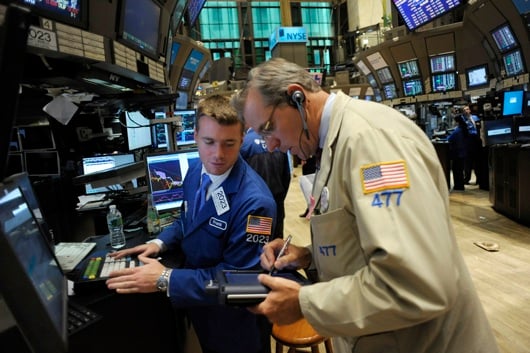U.S. stocks are set for a “significant rally” which will provide an opportunity for investors to sell before equities resume declines, according to economist Andrew Smithers.
Companies are cashed up and likely to buy back shares at a time when price-to-earnings ratios are low, providing a trigger for a short-term rally, said Smithers, who claimed stocks were overvalued in 2000 before a near 50 percent decline over 2 1/2 years. Investors should sell shares once their holdings gain 10 percent because even after the recent rout, U.S. stocks are about 40 percent above fair value, the president of research company Smithers & Co. said in an e-mail on Aug. 18.
“There is a good chance of a rally because of the cash position of U.S. companies, their tendency to buy shares when they have high cash ratios and the importance of company share buying on the stock market,” Smithers said. “A 10 percent rally would be an opportunity to sell.”
About $8.2 trillion was wiped off the value of global equity markets from July 22 through Aug. 19 as Europe's debt crisis deepened and investors speculated the U.S. economy may contract. Standard & Poor's 500 Index companies have about $291 in cash and short-term investments per share, according to data compiled by Bloomberg. That's the highest since 1998, when Bloomberg data became available.
Futures on the S&P 500 Index expiring in September gained 0.9 percent at 5:45 a.m. in New York today, after falling as much as 1 percent as German Chancellor Angela Merkel said she would resist a common euro-area bond to fight the debt crisis.
‘Hold Cash'
Smithers said in a report dated Aug. 15 that the S&P 500 is still overvalued by about 43 percent relative to earnings for the past 10 years, a time frame endorsed by Yale University's Robert J. Shiller. Relative to the Q ratio, a comparison of market value with the replacement cost of assets, the index is about 36 percent too high, he said.
“Investors should not, in general,
buy stocks at this level, as the stock market is likely to become cheap at some time during the next 10 years and there is therefore a high risk that anyone buying today will lose money before they start to get a positive return,” Smithers said. “In these circumstances, they are likely to be better off by holding cash until the market has fallen.”
Smithers uses Equity Q, a variant of a ratio made famous by Nobel Laureate James Tobin, as an indicator of whether the market is overvaluing or undervaluing company assets. He uses estimates of market value published by the Federal Reserve.
Poor Performance ‘Amplified'
Investors are “foolish” to use price ratios based on current earnings as a yardstick of whether the market is attractive, Smithers argues. The S&P 500 lost 16 percent from this year's high on April 29 through Aug. 19 and trades at 12.3 times trailing earnings, close to the level in March 2009, when stocks bottomed after Lehman Brothers Holdings Inc. collapsed. The average of since 1954 is 16.4 times, according to data compiled by Bloomberg.
“There are widespread claims that the U.S. stock market is attractive,” Smithers wrote on Aug. 15. “While foolish, these views are common. The risk that I see for those who have to take a short-term view is that their relative performance will suffer in a rally and that this will drive them to buy if the market does rally which, given the bad medium-term outlook, would amplify their poor performance.”
More U.S. companies are buying back stock than at any time since October 2008, according to data compiled by Birinyi Associates Inc.
“Corporate buying has moved with the stock market in recent years,” Smithers wrote. “Companies are likely to use their cash resources to buy shares.”
‘Very Foolish'
Cash holdings for the S&P 500 companies have been boosted by the highest profit margins since 2006, according to data compiled by Bloomberg. Interpreting wider profit margins as an indicator for economic expansion is a mistake, said Smithers, because such margins imply companies are either paying their employees too little, employing too few people or keeping their prices too high, all of which damp demand.
“It is common to find that investors, often supported by ill-judged comments by investment bankers and financial journalists, try to value shares on the basis of current profits,” he wrote. “This is, of course, very foolish as it means that they undervalue companies when profits are low and overvalue them when profits are high -- as they are today.”
This isn't the first time Smithers has said the market is expensive. In October 2009, he said the S&P 500 was about 40 percent overvalued and would drop as central banks were likely to wind up programs to stimulate the economy during the global financial crisis.
Asset Purchases
The S&P 500 gained about 23 percent from Oct. 2009 through June 30 this year as the U.S. Federal Reserve kept interest rates near record lows and embarked on a second program of asset purchases. The asset-purchase program finished at the end of June. The S&P500 has fallen 15 percent since then.
Smithers, who worked for 27 years at S.G. Warburg & Co., where he ran the investment management business before founding his own London-based research company, argued that U.S. equities were overvalued in a March 2000 book co-authored with fellow economist Stephen Wright entitled “Valuing Wall Street.” The S&P 500 Index (SPX) plunged 49 percent over 2 1/2 years from a record high reached that month.
“The U.S. market was more overvalued in 2000 than ever before,” said Smithers in the report on Aug. 15. “It has yet to become undervalued and will naturally do so at some stage. The bear market which started in 2000 is likely to be a long one.”
--Bloomberg News--







